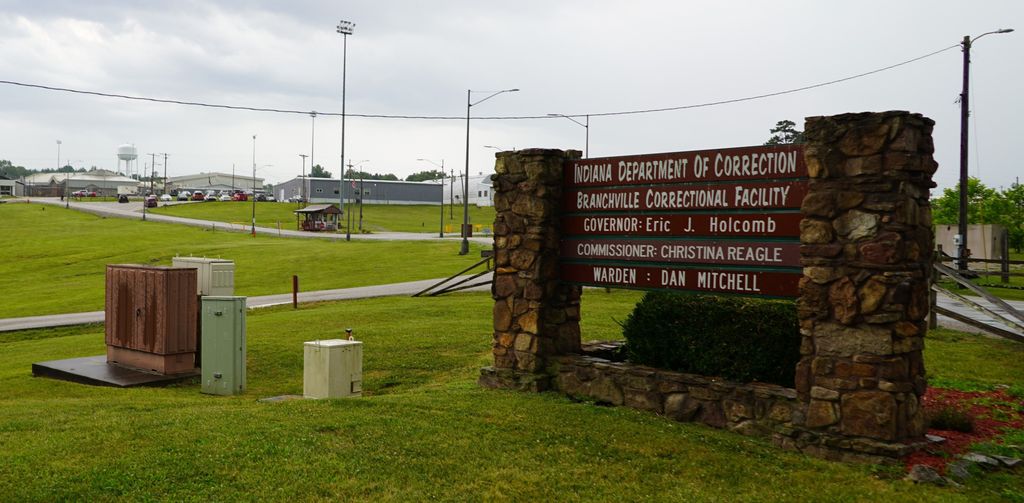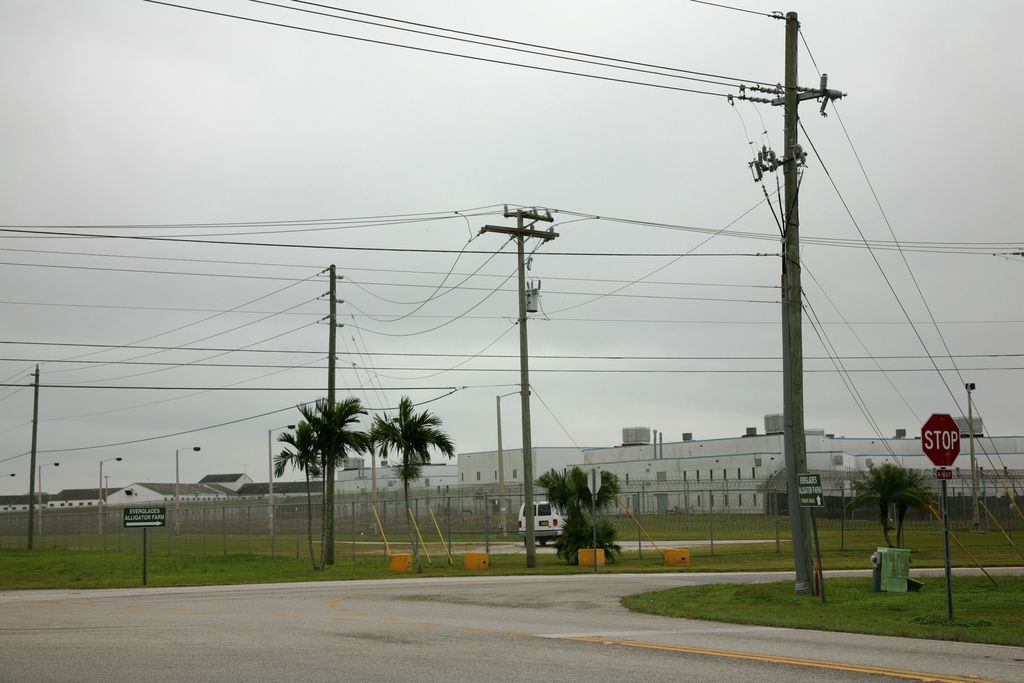
Indiana is poised to significantly expand its role in federal immigration enforcement with the upcoming establishment of the “Speedway Slammer,” a new facility designed to detain individuals in the country illegally. This initiative marks a deepening partnership between the state and the Trump administration, mirroring efforts seen in Florida, as states increasingly align with the federal government’s aggressive approach to immigration. The facility, which will add 1,000 beds to the national detention capacity, is slated to open at the Miami Correctional Center in Miami County, strategically located between Indianapolis and Fort Wayne.
The chosen moniker, “Speedway Slammer,” is a clear homage to Indiana’s storied racing culture, most notably the annual Indianapolis 500. This naming convention follows the precedent set by Florida’s “Alligator Alcatraz,” suggesting a broader rhetorical strategy by the administration to brand its immigration detention centers with memorable, evocative names. The site itself, the Miami Correctional Facility, is a maximum-security prison situated at the former Grissom Air Force Base, offering a substantial infrastructure for the new operation.
Indiana Governor Mike Braun articulated his support for the partnership, highlighting the state’s commitment to federal immigration goals. In a statement released on Tuesday, Governor Braun affirmed, “We are proud to work with President Trump and Secretary Noem as they remove the worst of the worst with this innovative partnership.” He further emphasized Indiana’s proactive stance, stating, “Indiana is taking a comprehensive and collaborative approach to combating illegal immigration and will continue to lead the way among states.”
The funding for this expansion is primarily sourced from a reconciliation bill signed by President Donald Trump last month, which was notably dubbed the “one big, beautiful bill.” This legislative measure plays a crucial role in enabling the increased detention capacity by providing financial backing for the 287(g) program. This program is designed to foster collaboration between Immigration and Customs Enforcement (ICE) and local governments, thereby enhancing their ability to enforce federal immigration laws within state jurisdictions.

Moreover, the “one big, beautiful bill” has authorized funding for an additional 80,000 ICE detention beds nationwide, signaling a substantial increase in the administration’s capacity for detaining migrants. This overarching federal funding mechanism underscores the scale and ambition of the Trump administration’s deportation initiatives, providing a robust financial framework for facilities like the “Speedway Slammer” and its predecessors.
Department of Homeland Security Secretary Kristi Noem officially announced the forthcoming Indiana facility on August 5, echoing the administration’s firm message to those residing in the country without authorization. In a direct statement, Secretary Noem warned, “If you are in America illegally, you could find yourself in Indiana’s Speedway Slammer.” She also explicitly encouraged self-deportation, advising, “Avoid arrest and self deport now using the CBP Home App.”
Secretary Noem’s announcement on X reiterated the core objective of the new facility and the nature of the partnership. She wrote, “COMING SOON to Indiana: The Speedway Slammer. Today, we’re announcing a new partnership with the state of Indiana to expand detention bed space by 1,000 beds.” Her message underscored the cooperative effort, adding, “Thanks to Governor Braun for his partnership to help remove the worst of the worst out of our country.”

The Indiana Department of Correction will collaborate directly with ICE to make these 1,000 beds available at the Miami Correctional Facility. This partnership formalizes Indiana’s commitment to assisting in the federal government’s mass deportation efforts. The facility is intended to house what officials describe as “some of the worst of the worst criminal illegal aliens arrested by ICE,” reinforcing the administration’s emphasis on removing individuals deemed to pose the highest risk.
The establishment of the “Speedway Slammer” follows closely on the heels of Florida’s controversial “Alligator Alcatraz,” which commenced operations earlier this summer. This Florida facility, opened under the purview of federal officials and Governor Ron DeSantis, serves as a significant precedent for Indiana’s new detention center. Both facilities represent key components of the Trump administration’s broader strategy to create designated stopping points for individuals in the country illegally before their deportation.
Florida’s “Alligator Alcatraz” began operations in July, located deep within the Everglades at a defunct airport site, specifically the Dade-Collier Training and Transition Airport, inside the Big Cypress National Preserve. This facility was initially outfitted with tent structures and has a capacity for 2,000 detainees, with plans to expand to accommodate 4,000 individuals in the future. The unique location and setup highlight the administration’s innovative, albeit often criticized, approaches to detention.
Deportation flights from “Alligator Alcatraz” commenced by the end of July, signaling the operational effectiveness of the facility in accelerating removals. Governor DeSantis reported on these initial successes, stating, “I’m pleased to report that those flights out of Alligator Alcatraz by DHS have begun. The cadence is increasing.” He added, “We’ve already had a number of flights, in the last few days, we’ve had hundreds of illegals [that] have been removed from here.”

Governor DeSantis further elaborated on the strategic advantage of the Florida facility’s location, emphasizing its direct utility for deportation operations. “The whole purpose is to make this be a place that can facilitate increased frequency and numbers of deportations of illegal aliens, that is the goal,” DeSantis said. He noted the logistical benefit of the on-site runway: “And one of the reasons why this was a sensible spot is because you have this runway that’s right here. You don’t have to drive up an hour to an airport. You go a couple of thousand feet, and they can be on a plane and out of here.”
The “Alligator Alcatraz” facility, however, has not been without significant controversy. Its location and operational intent drew sharp criticism from both left-wing immigration and environmental activists. Opponents have raised serious concerns about the conditions within the facility and its impact on the natural environment, particularly in a sensitive ecosystem like the Everglades.
Melissa Abdo, PhD, the National Parks Conservation Association Sun Coast Regional Director, issued a statement on July 1 expressing strong opposition to the Florida site. She described the proposal as “cruel and absurd,” asserting, “Building a bare-bones tented detention center on hot tarmac in the middle of the Everglades and exposing imprisoned immigrants to the elements is a cruel and absurd proposal.”

Dr. Abdo also highlighted the inherent dangers posed by the Everglades’ harsh climate. She warned, “The Everglades’ intense heat, humidity, and storms can be hazardous without proper precautions.” Furthermore, she cautioned that “This facility’s remote, harsh nature could leave people in very real danger, especially as Florida’s heat index skyrockets and hurricane season escalates,” underscoring the humanitarian and environmental risks.
Indiana’s involvement in expanded immigration enforcement extends beyond the “Speedway Slammer.” In recent months, local advocacy groups and Indiana residents have voiced increasing concerns about the state’s growing alignment with the Trump administration’s immigration objectives. This public discourse reflects a contentious debate within the state regarding the implications of these policies for local communities.
An earlier announcement on July 15 by Defense Secretary Pete Hegseth outlined plans to potentially use Camp Atterbury, a military facility operated by the Indiana National Guard, as another temporary site for DHS. According to Democratic U.S. Representative André Carson, the Trump administration is prepared to hold up to 1,000 ICE detainees at this location. However, Governor Braun indicated that as of August 5, the Trump administration has not yet established a timeline for converting Camp Atterbury into an immigration detention center.

The Miami Correctional Facility, chosen for the “Speedway Slammer,” is a large prison capable of housing approximately 3,100 people. Annie Goeller, chief communications officer for the Indiana Department of Correction (IDOC), noted that a portion of the facility has remained unfilled due to ongoing staffing shortages. The addition of 1,000 beds for immigrant detainees would likely address some of this unused capacity, although the details of staffing for the new wing were not immediately available.
Governor Braun has consistently affirmed Indiana’s intention to cooperate fully with federal authorities on immigration matters. He stated to the IndyStar, “When it comes to our state, we’re going to cooperate … as we’re housing detainees that have broken the law after they entered illegally, we’re going to cooperate with the federal government.” He also acknowledged the importance of due process, adding, “When it comes to any of the other issues on due process and so forth, we want to make sure we’re doing that the right way as well.”
The strategic expansion of detention capacity, as exemplified by the “Speedway Slammer” and “Alligator Alcatraz,” illustrates a pivotal shift in the nation’s immigration enforcement landscape. These facilities, funded by a substantial federal bill, are central to the administration’s stated objective of increasing the frequency and efficiency of deportations. The emphasis on offering incentives for self-deportation, such as $1,000 and free travel, presents an alternative pathway for individuals without additional criminal records to exit the country, with the potential to return legally, according to DHS.

As Indiana prepares to open its “Speedway Slammer,” the initiative underscores a comprehensive, state-federal collaborative approach to combating illegal immigration, as described by Governor Braun. This ongoing development highlights a nationwide push to bolster detention infrastructure and streamline deportation processes. The trajectory of these facilities and their impact on both the individuals detained and the broader communities remain a subject of considerable national discussion and scrutiny, shaping the future contours of immigration policy in the United States.


